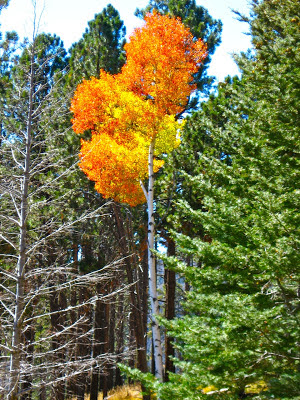Here's a brief layman's explanation as garnered from this and this websites: The yellow and orange are there year around in the aspen leaves but are masked by the green chlorophyll formed during photosynthesis. In the fall, the aspen stops photosynthesis by building a "corky" layer between the leaf stem and branch. The green color now disappears and then the yellow and orange that was there all along is visible. These colors are from carotenoids like carotene and xanthophyll, as found in carrots and yellow peppers.
Ah, but why the red aspen leaves? The red is from anthocyanin, like in Red Delicious apple skin. The anthocyanin is not in the aspen leaves year around. My understanding of this is on a simple level. I'm sure it's more complex: When the "corky" layer forms between the leaf stem and branch and the aspen leaves are thus cut off from the water and nutrients of the tree, anthocyanin is made from the sugar now left in the leaves, turning the leaves a brilliant red. Anthocyanin formation is enhanced by bright sunlight, dry days, cool but above freezing nights and also by the particular genetic makeup of the aspen clone.
OK - does this mean I can get my daily quota of carotenoids and anthocyanin by eating tasty, sugar-filled aspen leaves instead of carrots, yellow peppers and red apples?? Today, to find out, I tasted a tiny bit of red aspen leaf. I immediately realized it was spit-it-out-right-away-bitter! Any sugar trapped in the leaves must be infinitesimal. I suspected this but had to be sure!! (To be honest, I'd once tasted aspen bark to see why elk like to nibble it - it had the same ack-OMG-I'm-poisoned taste but with a nice finish of wintergreen after I spat it out!)

No comments:
Post a Comment